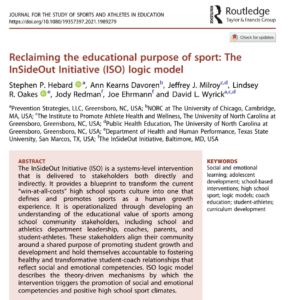Innovative Implementation
InSideOut Initiative is both an innovation and a process involving a paradigm shift in the way athletic administrators and coaches are viewed as an instrumental part of the educational system. InSideOut Initiative is uniquely innovative in that it is the first systems-level intervention to prioritize social-emotional and character development in high school athletics. The extension of social-emotional and character development outside of the classroom and into other critical developmental arenas is necessary.
The implementation of InSideOut’s four-phase initiative and Five-Step Pathway to becoming a purpose-based, transformative culture, represent an important innovation in implementation science.
The Science of InSideOut
IPAHW’s evaluation team is conducting self-report survey research, focus groups, and interviews to provide an initial, comprehensive picture of how ISOI impacts organizational/cultural and individual-level changes within school communities. The five key elements described here represent the focus for evaluation.

- Social-emotional development
InSideOut training reflects the competencies associated with Social and Emotional Learning (SEL). SEL is a well-researched process by which students and adults acquire knowledge and apply skills regarding emotional and interpersonal processing, character-oriented values and perspectives, healthy self-image, and ultimately, a healthy relationship with self and the surrounding world. - Innovative Implementation
InSideOut’s systems-level approach to individual and community-level change incorporates the three phases of training, the implementation of the Five-Step Pathway, and a unique, “leading from the middle” diffusion model that engages stakeholders across school communities and beyond. - Motivating Stakeholders Toward Change
Individual behavior change is best explained by the Theory of Planned Behavior and Self-Efficacy Theory. As a stakeholder is educated, their beliefs, attitudes, perceived ability, and control of relevant behaviors change. As a result, athletic administrators and coaches behave in ways that promote an InSideOut-aligned philosophy in their school communities. - Organizational Change — The Role of Leadership
Community-level change requires an agreement between individual and organizational goals. When a key school leader successfully implements the Five-Step Pathway, a nurturing community will exhibit caring behaviors that prioritize the social and emotional development of student-athletes. As the surrounding community perceives these behaviors as “good,” they adopt purpose-based values. - Sustainable Social Learning via Communities of Best Practice
InSideOut’s Communities of Best Practice bring stakeholders with a passion for purpose-based athletics together to share ideas and resources, build relationships, and develop creative solutions to the challenges of personal and school community culture change.

